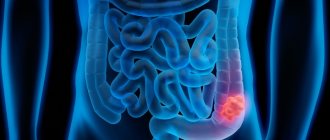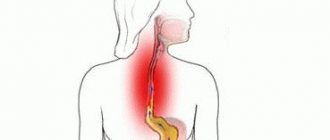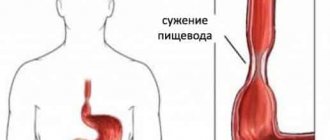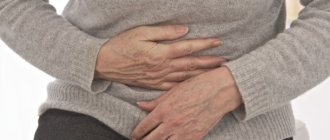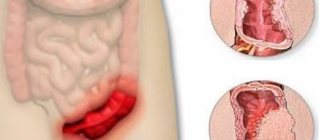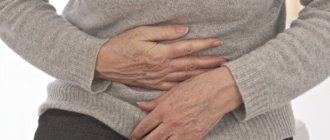Stages of intestinal obstruction
Intestinal obstruction is characterized by a staged course. The stages include:
- Stage of “ileus cry”. Its duration ranges from 2 hours to 14 hours. Symptoms include severe pain.
- Intoxication stage. Lasts from 12 hours to 36 hours. It is based on “imaginary well-being,” which reduces the severity of pain and weakens intestinal peristalsis. Symptoms of intestinal obstruction also appear, such as: delayed excretion of feces and gases, bloating.
- Terminal stage. It occurs 36 hours after the onset of the first symptoms and is manifested by symptoms of circulatory pathology and peritonitis.
Symptoms of small intestinal obstruction
Symptoms of intestinal obstruction are quite specific and characteristic:
- Pain. In acute intestinal obstruction, it occurs suddenly and has an increasing character. It reaches its greatest peak against the background of peristaltic contractions, and then may weaken for several minutes. A few hours after the onset of the disease, the pain becomes unbearable. In the absence of treatment, it subsides for about 2-3 days, when intestinal paralysis develops. This is a very formidable sign, which is why it is called a symptom of grave silence.
- Vomit. With small intestinal obstruction, vomiting develops quite quickly and is associated with reflex irritation of the gastrointestinal tract.
- Bloating. With intestinal obstruction, bloating has characteristic features - the abdomen becomes asymmetrical, you can palpate the bulge of the adductor intestine and even see its peristaltic contractions. When percussed, a tympanic sound is heard.
In the clinical picture of small intestinal obstruction, three stages are distinguished:
- Early stage—it lasts up to 12 hours from the onset of the first symptoms. The main symptoms of this period are increasing abdominal pain and vomiting (in some cases it may be absent).
- The intermediate stage lasts from 12 hours to a day. At this stage, symptoms increase, and a full-fledged clinical picture unfolds. The pain becomes very severe and even unbearable, the abdomen enlarges, and symptoms of dehydration develop.
- Late stage - the period after a day from the onset of clinical manifestations of intestinal obstruction. The patient's condition rapidly deteriorates, symptoms of intoxication increase, temperature increases, changes in acid-base and electrolyte balance are noted, and failure of the cardiovascular and respiratory systems occurs. At the same time, peritonitis and sepsis develop.
Classification of intestinal obstruction
Pediatric gastroenterologist in Volgograd
There are several classifications of the condition that take into account clinical mechanisms, pathogenesis and anatomical features. Based on these factors, you can make a correct diagnosis and select the correct methods of therapy that are suitable in a particular case.
Based on morphofunctional reasons, the following types of obstruction are distinguished:
- Dynamic. Its subtypes include paralytic and spastic.
- Mechanical. There are three forms here, these include strangulation (strangulation, torsion, formation of nodes), obstructive (extra- and intraintestinal), and mixed (intussusception, adhesions).
- Vascular. It is provoked by infarction of the intestine.
The level of localization of the obstacle during the movement of digested food determines the division of obstruction into such conditions as:
- high small intestinal obstruction;
- low small bowel obstruction;
- colonic obstruction.
The degree of disturbance in the movement of digested food determines the division of the condition into complete or partial obstruction. Clinical forms of obstruction are acute, subacute and chronic. There is also a division of the condition into congenital (provoked by developmental defects) and acquired, or secondary.
Types and causes of intestinal obstruction
According to the nature of the course, acute intestinal obstruction is distinguished from chronic; intestinal obstruction can also be complete or partial.
By origin it can be congenital or acquired. Congenital intestinal obstruction in children is caused by abnormalities in the development of the intestine or blockage of it by dense meconium - feces formed during the intrauterine development of the fetus.
Depending on the cause that caused it, intestinal obstruction is divided into two types: dynamic and mechanical.
Dynamic intestinal obstruction is caused by disorders of innervation and blood circulation in the intestines.
In turn, it is divided into the following forms:
- Paralytic intestinal obstruction. It occurs as a result of paralysis of the muscular layer of the intestine, which stops peristalsis - the movements that move chyme through the intestines. It is a complication of peritonitis (inflammation of the peritoneum). Paresis (partial paralysis) of the intestine occurs with renal and biliary colic, acute attacks of pancreatitis, injuries of the pelvis, spine and abdominal hematomas, and can also be postoperative;
- Spastic intestinal obstruction. The cause of spastic intestinal obstruction is intestinal spasm as a result of poisoning with certain medications and salts of heavy metals.
Mechanical intestinal obstruction is the most common type of intestinal obstruction. Divided into the following subspecies:
- Obstructive intestinal obstruction. Occurs in the presence of a neoplasm that partially or completely blocks the intestinal lumen (fecal stones, tumors, cysts, helminth balls), it is characterized by a gradual increase in symptoms;
- Strangulating intestinal obstruction. Associated with compression or strangulation of the intestinal mesentery (volvulus, intestinal nodes), this type is characterized by rapid development, 4-6 hours from the moment of onset until complete obstruction;
- Mixed or combined intestinal obstruction. Occurs during intussusception, when the intestinal lumen is clogged by an invading intestine, and the mesentery of the invading loop is compressed. Intussusception is the most common cause of intestinal obstruction in children.
Intestinal obstruction is also classified by level:
- Small intestinal obstruction;
- Large intestinal obstruction;
- High intestinal obstruction;
- Low intestinal obstruction.
General signs of the disease in adults, children and newborns
Causes and treatment of intestinal obstruction in newborns
Intestinal obstruction can be accompanied by a number of different symptoms. In adults, the pathology begins to manifest itself with the development of cramping pain, which most often has an increasing character.
Additional symptoms include:
- nausea;
- vomit;
- unpleasant smell of vomit;
- constipation;
- flatulence;
- bloating;
- the stomach takes on a characteristic irregular shape;
- peristalsis is clearly visible through the abdominal wall;
- dry mouth;
- pressure drop;
- cardiopalmus.
Clinic for obstruction in children:
- severe abdominal pain;
- bloating;
- vomit;
- severe anxiety;
- change in the shape of the abdomen.
In children, intestinal obstruction is even more acute than in adults. Thus, the pain syndrome is so clearly expressed that the child is not able to cry, but only spins restlessly. The general condition rapidly deteriorates within the first hours.
Symptoms of obstruction in newborns are as follows:
- bloating and pain when palpated;
- vomiting mixed with bile;
- difficult passage of gases or their absence at all;
- the child has Down syndrome;
- stool disorders, delay or complete absence;
- restless state.
Forms
Intestinal obstruction is a syndrome that has various forms of symptoms. When conducting conservative research methods, the doctor is obliged to identify the type of problem, based on the severity of the signs of the disease.
- Val's symptom - represents visible outlines of asymmetry in the lower abdomen, peristalsis is clearly visible.
- Schlange's sign is pronounced intestinal peristalsis, which is easily distinguishable by eye.
- Sklyarov's symptom is the sound of intestinal splashing. Their absence is a bad sign.
- Kivul's symptom is the appearance of a metallic sound when tapping is performed to identify the existing condition of the organ.
- Anschutz's symptom is a strong manifestation of flatulence in the right iliac region.
- Tiliax's symptom is the periodic appearance of increasing cramping pain.
- Cruvelier's sign is the presence of bloody discharge from the colon.
- Babuk's symptom is the appearance of characteristic meat residues in the stool, the presence of red blood cells in the intestinal contents.
- Grekov's symptom - the presence of an empty distended intestine, sphincter dysfunction.
- Bailey's sign is hearing heart beats on the abdominal wall.
- The Spasokukotsky-Williams symptom is the presence of a “falling drop” noise, which reveals weakened intestinal motility.
Symptoms of partial obstruction
Partial intestinal obstruction most often occurs in children who have undergone abdominal surgery. It can occur when adhesions or benign or malignant neoplasms appear.
With this pathology, a person’s condition rapidly deteriorates and reaches the full stage. Thus, the vessels that feed the intestines are compressed.
This condition can sometimes be chronic. So, the symptoms persist and periodically make themselves felt.
Partial obstruction can manifest itself as follows:
- stomach ache;
- frequent stool retention - scanty diarrhea;
- nausea;
- vomit;
- severe bloating.
Partial intestinal obstruction is associated with slow progression of intestinal masses due to a narrowed lumen in the intestinal area. This pathology belongs to the dynamic type of disorder and is associated with dysfunction of the intestinal wall.
Symptoms of acute intestinal obstruction
Acute intestinal obstruction is an extremely dangerous condition in which the normal passage of gastrointestinal contents is disrupted.
The symptoms of acute obstruction are quite similar to partial ones. However, it occurs more quickly, aggressively and pronouncedly.
- severe abdominal pain that occurs regardless of meal time;
- nausea;
- severe vomiting (the stronger the level of obstruction, the more severe the vomiting);
- bloating;
- no gas emissions;
- bowel disorder.
If such a condition occurs, you must immediately contact an ambulance. Precious wasted time can determine a far from favorable prognosis for treatment.
Clinical picture
Mechanism of formation of acute intestinal obstruction
The clinical picture of the acute form of obstruction manifests itself very clearly - a gradual increase in the intensity of symptoms is not typical for the disease. The disease is expressed by symptoms of intestinal dysfunction:
- nausea and vomiting;
- intense pain syndrome;
- flatulence and increased peristalsis (the intestine itself tries to push through the barrier that blocks its lumen);
- impaired excretion of feces and gases. A person usually experiences constipation.
The pain syndrome in acute intestinal obstruction is very intense. The pain is localized in the navel area, but does not radiate. Has a cramping character. At the time of an attack, a person takes a forced position, which allows him to slightly reduce the manifestation of pain. During this period, the patient may show signs of shock - increased heart rate, pale skin, cold and sticky sweat, etc. Already when this symptom is expressed, it is necessary to take the patient to a doctor and carry out a diagnosis that will make it possible to determine the true cause of the condition.
The second symptom is vomiting. Based on its character, the doctor can even tell at what level the intestinal lumen was blocked. For example, if the vomiting is profuse and particles of food that a person consumed the day before are visible in it, then in this case the small intestine is affected. But it also happens that first vomit with food particles is released, then it turns yellow due to the admixture of bile, and then dark green - fecal vomit. This indicates damage to the large intestine.
Impaired excretion of feces and gases. At first, this process may not be disrupted, since the lower parts of the intestine are reflexively emptied. But after this, persistent constipation and bloating develop. A visual examination can reveal that the patient’s abdomen is enlarged, but asymmetrically. In addition, enhanced peristalsis can be noted on it.
If such signs are expressed, you cannot hesitate - you need to take the patient to a medical facility to a surgeon who can carry out a full diagnosis and treatment of acute intestinal obstruction.
Diagnostics
Strangulation intestinal obstruction: why it occurs, symptoms, principles of treatment
Pathology can be suspected based on characteristic signs and the presence of a history of inflammation and surgery in the abdominal area. To confirm the diagnosis, plain and contrast radiography are used. The images show stretched intestinal loops, areas containing liquid and free gases, and other changes in the structure of the digestive tract characteristic of SCI.
Additionally, ultrasound, computed tomography and magnetic resonance imaging are prescribed. With their help, specialists determine the severity of the adhesive process and identify the cause of the pathology. An effective diagnostic method is laparoscopy.
Etiology
The development of mechanical intestinal obstruction is based on anatomical prerequisites of a congenital or acquired nature. Such predisposing moments
There may be congenital dolichosigma, a mobile cecum, additional pockets and folds of the peritoneum. More often, these factors are acquired in nature: adhesions in the abdominal cavity, elongation of the sigmoid colon in old age, hernias of the anterior abdominal wall and internal hernias.
The adhesive process in the abdominal cavity develops after previous inflammatory diseases, injuries and operations. For the occurrence of acute intestinal obstruction, isolated interintestinal, intestinal-parietal, and parietal-epiploic adhesions are of greatest importance, forming rough cords and “windows” in the abdominal cavity, which can cause strangulation (internal strangulation) of mobile intestinal segments. No less dangerous clinically are flat interintestinal, intestinal-parietal and intestinal-epiploic adhesions with the formation of intestinal conglomerates, leading to obstructive obstruction with functional overload of the intestine.
Another group of acquired factors contributing to the development of intestinal obstruction are benign and malignant tumors of various parts of the intestine, leading to obstructive obstruction. Obstruction can also occur due to compression of the intestinal tube by an external tumor emanating from neighboring organs, as well as narrowing of the intestinal lumen as a result of perifocal tumor or inflammatory infiltration. Exophytic tumors (or polyps) of the small intestine, as well as Meckel's diverticulum, can cause intussusception.
In the presence of these prerequisites, obstruction occurs under the influence of provoking factors
. For hernias, this may be an increase in intra-abdominal pressure. For other types of obstruction, provoking factors are often changes in intestinal motility associated with changes in diet:
- eating a large amount of vegetables and fruits in the summer-autumn period;
- mobile eating during prolonged fasting (possible volvulus of the small intestine);
- transition from breastfeeding to artificial feeding in children of the first year of life (a common cause of ileocecal intussusception).
The causes of dynamic intestinal obstruction are very diverse. Most often, paralytic obstruction occurs, developing as a result of trauma (including operating room), metabolic disorders (hypokalemia), and peritonitis. All acute surgical diseases of the abdominal organs, which can potentially lead to peritonitis, occur with symptoms of intestinal paresis. A decrease in peristaltic activity of the gastrointestinal tract is noted with limited physical activity (bed rest) and as a result of long-term intractable biliary or renal colic. Spastic intestinal obstruction is caused by lesions of the brain or spinal cord (metastases of malignant tumors, tabes dorsalis, etc.), poisoning with heavy metal salts (for example, lead colic), and hysteria.
Causes of adhesive disease
The most common cause is surgery on the abdominal organs. Adhesions occur after 93% of surgical interventions. If the operation was performed in the pelvic area involving the intestines or uterus with appendages, then the risk of adhesions increases. The process of thickening and compaction of adhesions can continue for decades.
Possible reasons that provoke the formation of adhesions:
- damage to internal organs;
- drying of the surface of internal organs during surgery;
- contact of internal tissues with foreign objects, such as gauze, surgical gloves, suture material, instruments;
- blood, damaged tissue or blood clots, foreign bodies not completely removed during surgery.
Conditions not directly related to surgery may also be the cause:
- rupture of the appendix, gallbladder;
- radiation therapy;
- gynecological infections;
- abdominal infections;
- injuries.
In 4.7% of cases, adhesions are congenital; their formation occurs during the formation of organs.
In rare cases, adhesions may occur for no apparent reason.
Features of the condition of intestinal obstruction
Intestinal obstruction, or ileus, is a complex of symptoms rather than an independent nosological entity. Gastroenterologists and coloproctologists say that intestinal obstruction accompanies many pathological processes.
In this condition, the movement of chyme through the small and large intestines is difficult. Intestinal obstruction is a polyetiological condition, that is, it can be caused by a variety of reasons. The forms of the condition are also diverse. The earlier the condition is identified, the more gentle treatment measures are applied and the greater the likelihood of successful treatment.
Description
Intestinal obstruction is a violation of the passage of intestinal contents - food masses and intestinal juices. There are complete and partial obstruction; along the course - acute, with a sudden disruption of intestinal patency, and chronic, developing gradually or manifested by repeated attacks of relative obstruction due to partial disruption of patency during adhesive disease and (less often) when the intestine is obstructed by a slowly growing tumor. According to the mechanism, intestinal obstruction can be dynamic and mechanical in nature.
Adhesive intestinal obstruction ICD code 10
Intestinal obstruction, or ileus, is a complex of symptoms rather than an independent nosological entity. Gastroenterologists and coloproctologists say that intestinal obstruction accompanies many pathological processes.
In this condition, the movement of chyme through the small and large intestines is difficult. Intestinal obstruction is a polyetiological condition, that is, it can be caused by a variety of reasons. The forms of the condition are also diverse. H
Intestinal obstruction is characterized by a staged course. The stages include:
- Stage of “ileus cry”. Its duration ranges from 2 hours to 14 hours. Symptoms include severe pain.
- Intoxication stage. Lasts from 12 hours to 36 hours. It is based on “imaginary well-being,” which reduces the severity of pain and weakens intestinal peristalsis. Symptoms of intestinal obstruction also appear, such as: delayed excretion of feces and gases, bloating.
- Terminal stage. It occurs 36 hours after the onset of the first symptoms and is manifested by symptoms of circulatory pathology and peritonitis.
Short description
Intestinal obstruction (ileus) is a complete cessation or disruption of the passage of intestinal contents through the digestive tube. Frequency: 9–20% of patients with symptoms of acute abdomen (usually men 40–60 years old).
Clinical picture• Abdominal pain. Irradiation is not typical, but with volvulus of the small intestine, the pain radiates to the lumbar region. Pain during obstructive obstruction is cramping, appears at the moment of the occurrence of a peristaltic wave, and subsides or disappears between peristaltic waves. With strangulation obstruction, the pain is severe and constant.
• Vomiting with high obstruction - repeated, not bringing relief; with low intestinal obstruction - rare. In the later stages of the disease, vomit takes on a fecal odor. • Retention of stool and gases. • Intoxication: in the early stages, patients are excited, in the later stages they are adynamic, inhibited, consciousness is confused;
Body temperature in the final stages rises to 38–40 °C. • Abdominal bloating may be absent with high intestinal obstruction; with obstruction of the lower parts of the small intestine, bloating is symmetrical; with colonic obstruction, it is asymmetrical. • Peristaltic noises are intensified in the first hours, audible at a distance, with intestinal necrosis and peritonitis they weaken and disappear (symptom of “deathly silence”).
https://www.youtube.com/watch?v=ytdevru
• Shlange's sign - when examining the abdomen, intestinal peristalsis is visible, which is most pronounced in subacute and chronic obstructive obstruction. • When percussing the abdomen, a tympanic sound with a metallic tint is determined (Kivul's symptom). • During palpation, stretched intestinal loops are felt (Val's symptom).
Stages of the course The onset of the disease is characterized by a duration of up to 12 hours, pain and increased gas formation.
Intermediate stage. In this case, there is a decrease in pain, but an increase in dehydration and poisoning by toxins from the intestines. The duration of the period is 1-15 days. The terminal stage is the last stage of disease development. Pathogenic microorganisms begin to actively multiply in the intestines, dehydration and disruptions in the functioning of systems reach their peak.
- — The pain is sharp, cramping, lasting 10 minutes or more. Localization around the navel or in the pit of the stomach.
- - Flatulence, bloating, tension in the abdominal muscles.
- - Alternating diarrhea and constipation.
- - Decreased or complete absence of appetite.
- — Gurgling sounds in the stomach and rumbling are often observed.
- - Increased body temperature.
- - Lethargy, general weakness.
- - Dry and coated tongue with a white coating, possible increase in its size.
- - Nausea, vomiting. When there is obstruction of the small intestine, the vomit initially has the color and smell of the food eaten the day before. After some time, the intestines, having no other way out, begin to push feces upward. As a result, the vomit appears yellow, greenish, or brown in color and has an unpleasant smell of feces. With obstruction of the large intestine, there is no vomiting. Painful attacks of spastic pain, constant nausea and rumbling in the stomach predominate.
- - Possible bloody diarrhea. This indicates the opening of internal intestinal bleeding.
In children under one year of age, symptoms often include constipation, bloating and lack of gas production. Vomiting or excessive regurgitation is possible. Abdominal pain is paroxysmal. The baby is restless, eats and sleeps poorly, and often cries. Up to 10 months of life, intussusception is possible, that is, the retraction of one section of the intestine into another.
Diagnostic measures for intestinal obstruction
To diagnose obstruction, the following measures are taken:
- Percussion of the abdomen. This is characterized by a tympanic sound with metallic tones, or Kivul’s symptom. Percussion sound is dull.
- Auscultation of the abdomen. At an early stage - excessive peristalsis and “splashing noise”, at a late stage - “noise of a falling drop”, weak peristalsis.
- Palpation of the abdomen. The doctor determines the distension of the intestinal loops, or Val's sign, and at a later date, rigidity of the abdominal wall appears.
- Rectal and vaginal examination. They help determine blockage of the rectum, as well as identify a tumor process in the pelvic area.
- Survey radiography. The technique allows you to identify intestinal arches, Kloiber cups and symptoms of pinnateness.
- X-ray examination using contrast is prescribed in cases where diagnosis is difficult by other means.
- Colonoscopy. Sometimes this method is not only diagnostic, but also therapeutic, that is, it helps resolve intestinal obstruction.
- Ultrasound examination of the abdominal cavity. This technique is hampered by intestinal pneumatization, but it makes it possible to identify tumor and inflammatory infiltrative processes.
Differential diagnosis in case of intestinal obstruction consists in identifying the difference between the pathology and conditions such as:
- acute appendicitis;
- stomach or intestinal ulcer with perforation;
- acute form of cholecystitis;
- acute form of pancreatitis;
- renal colic;
- pregnancy with ectopic localization.
Description of the pathology
Intestinal obstruction in children is a pathology associated with a failure in the process of pushing chyme (broken down food with digestive juice) through the lumen. In babies of the first year of life, the disease is accompanied by severe pain, cramps, and vomiting. Most people use surgical tactics to eliminate pathology, especially in newborns. Older children are prescribed conservative treatment and diet.
In infants, the disease causes severe cramping pain.
Children's intestinal obstruction is a kind of blockage of the lumen. The complexity and severity of the disease depends on the location of the problem - the higher the blockage occurs, the more severe the disease will be. The peculiarity is the manifestation of specifically rapid symptoms in a vivid form. Correct and timely response in the form of treatment determines the outcome. If the chronic form is eliminated with medication, then the acute form can only be eliminated surgically.
Classification of intestinal obstruction in children
Intestinal obstruction in newborns and older patients is classified according to genetics, anatomical-physiological, and symptomatic parameters. Correctly determining the type of blockage allows you to prescribe adequate treatment and adjust the intensity of the measures taken. International classification:
- Based on origin, a distinction is made between congenital and acquired forms.
- According to the mechanism of formation - mechanical, dynamic.
- According to the characteristics of the symptoms - complete, partial, acute, chronic.
- According to the nature of compression of the vessels supplying the intestine with blood - strangulation, obstruction, mixed (with adhesions).
Congenital
The formation of intestinal obstruction can begin in the womb. This form of intestinal obstruction is formed in the womb against the background of fetal development abnormalities, so the newborn suffers from severe symptoms of dysfunction from the first hours. When the disease is particularly severe, the baby develops vomiting of bile and bloating. In mild forms of the disease, constipation and vomiting are observed. If this pathology is detected late, the risk of intestinal rupture increases. Manifestations of congenital pathology are stenosis (narrowing of blood vessels, lumen), atresia (fusion of organ walls), and inflammation. This form is typical for newborns.
Acquired
Pathology is provoked by external or internal unfavorable factors. It most often develops in infants aged from 4 months to a year in the form of intussusception (penetration of one part of the intestine from another) or a mechanical disorder. Adhesions are formed quite rarely. The characteristic features of the disease are an unexpected, paroxysmal pain syndrome that progresses to vomiting, and blood and mucus are found in the stool. A childhood illness requires immediate hospitalization of the baby.
Dynamic
Jumps in intestinal pressure provoke peritonitis. The development of this form is provoked by weakening of the regional blood supply to the mesentery, disruption of water and electrolyte balance, and dysfunction of the central nervous system departments responsible for correcting the functioning of the gastrointestinal tract. As a result, inflammation develops. The incidence is 10% of all recorded cases. Classification into subforms:
- paralytic, when the problem of atony arises against the background of the operation and is accompanied by paresis, a jump in intraintestinal pressure, which is fraught with intestinal rupture and peritonitis;
- spastic pathologies, characterized by excessive muscle tension, paroxysmal abdominal pain, absence of a jump in temperature, bloating, but vomiting is possible.
Mechanical
This pathology can be caused by the formation of adhesions in the body against the background of improper wound healing after intervention in the abdominal cavity. Depending on the causative factors, there are the following subforms:
- adhesive, formed against the background of adhesion;
- obstructive, formed when the intestinal lumen is compressed by tumor tissue, foreign bodies, parasites, or blockages with food bolus, but without compression of the mesenteric vessels.
Classification
Based on the etiological factor, the pathology is:
- primary - the sources of development cannot be determined;
- secondary - as a consequence of other diseases or occurring against the background of poor nutrition.
Depending on which parts of the gastrointestinal tract are involved in the pathological process, intussusception occurs:
- small intestine;
- colonic;
- gastric;
- small-colic;
- introduction of intestinal loops through natural fistula tracts or surgically placed stomas.
The most common location of intussusception in a child or adult is the small intestine.
According to the direction of peristaltic contractions, the disease is usually divided into:
- isoperistaltic or descending, i.e. from top to bottom;
- antiperistaltic or ascending - from bottom to top.
According to its structure, the intussusception can be:
- simple or complex;
- single or multiple.
Depending on the nature of the course, clinicians distinguish the following types of pathology:
- acute - occurs most often, in 95% of patients;
- recurrent - diagnosed in infants and treated with conservative methods, it can be early and late (in the first case, intussusception in children develops approximately 3 days after straightening of the intussusception, in the second - the introduction of one part of the intestine into another occurs 3 or more days after treatment);
- chronic - is periodic in nature and is often expressed by minor invasion of segments of the small intestine.
Separately, it is worth highlighting abortive intussusception - a type that resolves on its own.
It is extremely rare for patients to be diagnosed with the following forms:
- intussusception of the appendix;
- introduction of Meckel's diverticulum into the colon;
- multiple intussusceptions.
Gastroenterologists distinguish between external and internal intussusception.
Intussusception
What causes intestinal colic?
Colic is a consequence of irritation of the intestinal walls by a provoking factor. G
The smooth muscles respond to this with a strong contraction (spasm). Intense physical activity can trigger colic. During this, tension in the mesentery occurs, which leads to stabbing pain in the left side of the abdomen.
Colic occurs due to:
- Immaturity of gastrointestinal tract structures, flora insufficiency (in children).
- Eating heavy foods that contribute to the formation of gases (flour products, fried foods, soda).
- Exposure to large amounts of air when eating. This can happen if you talk during a meal or eat on the go.
- Constipation.
- Entry of a foreign body into the gastrointestinal tract.
- Food allergy (to lactose).
- Allergic reactions.
- Disorders of blood supply to various parts of the intestine. This occurs due to ulcerative formations and diverticulosis.
- Intestinal obstruction.
Treatment
A patient diagnosed or suspected of intestinal obstruction requires emergency hospitalization in the surgical department. Due to rapidly occurring, progressive, often catastrophic dehydration with high small intestinal obstruction, immediate therapy is required aimed at compensating for the enormous losses of fluid and electrolytes (infusion into a vein of 1.5 - 2 liters of isotonic sodium chloride solution, 5% glucose solution, polyglucin); such therapy should be carried out, if possible, during transport of the patient. Before being examined by a doctor, you should not give laxatives, administer painkillers, perform enemas or gastric lavages. In the hospital, in the absence of pronounced signs of mechanical obstruction, a set of conservative measures is carried out: suction of gastrointestinal contents through a thin probe inserted through the nose; with increased peristalsis, antispasmodics are administered. In case of mechanical obstruction, if conservative therapy is ineffective, emergency surgery is performed (dissection of adhesions, untwisting of the volvulus, deinvagination, resection of the intestine in case of necrosis, imposition of an intestinal fistula to drain intestinal contents in case of colon tumors). In the postoperative period, measures are continued aimed at normalizing water-salt and protein metabolism (intravenous infusions of saline solutions, blood substitutes), anti-inflammatory, anticoagulant therapy, stimulation of the motor-evacuation function of the gastrointestinal tract, etc.


